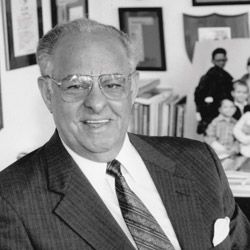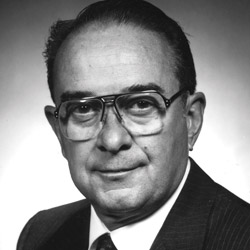It has been an interesting time to start a new business news publication. Reagonomics is gone. The Bush administration is a half-year old, struggling with inherited crisis in the twin deficits, Social Security, savings and loan industry, healthcare industry, etc. etc, while trying to maintain an expanding economy which is certainly heading for some kind of landing, soft, hard or otherwise. The "Big Jim" era in Illinois politics is drawing to a close. Sears will stay. DCCA will spend. Peoria is now an All-American City, emerging from the worst slump in its recent economic history. Cat is back and so are dozens of other industries. Someone did forget to turn the lights out when they left Peoria. -The Editors, August 1989
THE S&L BAILOUT
The official title is the "Financial Institutions Reform, Recovery and Enforcement Act of 1989." Most of us know it as "the Savings and Loan Bailout," and perhaps we should be entitled to name it since we’ll be paying for it. In what is widely recognized as the most far-reaching financial law since the Depression, Congress has passed and President Bush has signed legislation to stop the massive bleeding in the S&L industry, and to prevent nationwide economic chaos.
Not only is the federal government borrowing and borrowing, spending and spending; they are allowing private agencies to do the same thing without regulation and then saying, "Send us the bill." Unfortunately, free enterprise has to be free to fail as well as succeed. When you try to guarantee everything, ultimately you
guarantee nothing.
Three S&Ls are headquartered in Peoria. All have been in an insolvent position over the past year. Security Savings and Loan was put under RTC control on August 17th. Illinois Savings Bank was assumed earlier in March. The former Peoria Savings and Loan was sold last year and merged into the profitable River Valley Savings Bank.
HOUSING BOOM
While new housing construction nationwide is down nearly five percent this year, Peoria is experiencing the second consecutive year of a housing market boom. With 121 permits for single-family dwellings issued in the first six months, 1989 should surpass 1988’s total of 192, which was the most issued in a decade. The average price of new homes in Peoria this year is around $102,000.
Peoria’s rebounding economy has created a growing demand for:
- Larger, newer homes in the $100,000-plus price range.
- Apartment rentals. With a general influx of apartment dwellers and a growing demand by Caterpillar for rental facilities for employees, apartments are nearly impossible to locate, with rental costs steadily rising.
- Condominiums. Several large condominium developments are in progress at present, including a 60-unit $7.5 million project, a joint venture by Realtor Charles Rock and G. Raymond Becker.
IN OTHER NEWS…
After rising 158 places in Places Rated Almanac’s recent "Most Livable Spot in America" ratings to number 133, Peoria has just been designated as one of eight "rising stars" among medium-sized American cities.
Lifelong Peoria resident Marvin Hult has launched a unique promotional project with two goals: to tell the world about the rich, rewarding lifestyle of Peoria-area residents, and to raise funds for the soon to be completed Health Education Center. Titled "Surprising Peoria," the project centers around sales of a colorful new brochure of the same name. All proceeds will be donated to the Health Education Center, now under construction on North Knoxville near Proctor Community Hospital.
- Peoria will bid to become one of the 100 locations for a federal enterprise zone. No one knows just what a federal enterprise zone is just yet.
- Bradley University has already been forced to cut off freshman enrollment (up 20 percent) in the wake of enhanced national reputation and increased marketing efforts.
- Soon to open is The Grill on Fulton, a new Mercedes Restaurant, Inc. eatery in the Twin Towers.
- As negotiations continue with property owners around the proposed Campustown development, the City Council has authorized eminent domain on 22 properties.
- Peoria can look forward to a restored Apollo Theater building under the development of owner/attorney Tom Leiter and architect Gary Sandberg. The remodeling will preserve and restore original structures and recreate facsimiles of the original site.
- Illinois Central College will expand its downtown campus to twice its current size by the fall of 1990.
- The minimum wage will increase from $3.35 to $3.80 an hour on April 1, 1990 and to $4.25 an hour by April 1, 1991.
- The Greater Peoria Regional Airport continues to expand, with new entrance access, foreign trade and air cargo facilities, a cargo transfer park, and terminal building improvements heading the list. The new $56 million Air National Guard Base is expected to be completed in 1992.

An Interview with Mayor Jim Maloof
What will the All-American City status bring to Peoria in the way of dollars, development and jobs?
Well, first of all, becoming an All-American City is a tremendous plus for Peoria and comes at a great time, having suffered as we did in the early ‘80s with such horribly bad press…24th worst city in America; a city least likely to prosper in the ‘90s…We had all kinds of bad press which is hard to overcome…The community came together, prayed together, worked hard together and caused a new spirit…The program called "Forward Peoria" that I initiated when I was running for mayor in 1985 was the catalyst that brought people together, energized people, causing a new confidence and a new spirit. And it’s working.
What is the greatest way private industry can help strengthen Peoria’s economic recovery?
We are working very hard to keep Peoria from staying a one-industry town as it was for years with Caterpillar. Ten years ago, 68 to 69 percent of all our employees in the area were industrial. Today it is down to 51 percent, which means that Peoria now is blossoming, expanding…we are becoming an informational technology town…our agricultural program is blossoming because of new research programs going on at the research lab…It’s an exciting time for local businesses to expand.
What is the one thing that could most hurt Peoria’s economic recovery?
Complacency. See, when things are tough, people rally. This community, and this is a great community, in the worst of times in ‘84 and ‘85 gave more money to the United Way and the Salvation Army than at anytime in its history. In the worst of this time, Bradley University undertook a $26 million capital fund project, and they just announced that it is now nearly $36 million…So what could hurt the recovery? Complacency.
iBi



